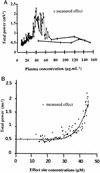Pharmacokinetic-pharmacodynamic modeling of the electroencephalogram effect of norfloxacin in rats
- PMID: 12760873
- PMCID: PMC155845
- DOI: 10.1128/AAC.47.6.1952-1957.2003
Pharmacokinetic-pharmacodynamic modeling of the electroencephalogram effect of norfloxacin in rats
Abstract
A previously developed pharmacokinetic-pharmacodynamic (PK-PD) modeling approach was used to investigate the epileptogenic activity of norfloxacin as a representative antibiotic with concentration-dependent antimicrobial activity. Rats received an intravenous infusion of norfloxacin at a rate of 5 mg kg of body weight(-1) min(-1) over 30 min. Blood samples were collected for drug assay, and an electroencephalogram (EEG) was recorded during infusion and postinfusion. An important delay was observed between concentrations of norfloxacin in plasma and the EEG effect. Indirect effect models failed to describe these data, which were successfully fitted by using an effect compartment model with a spline function to describe the relationship between effect and concentration at the effect site, as previously observed with imipenem. The robustness of the PK-PD model was then assessed by keeping the dose constant but increasing the duration of infusion to 120 and 240 min. Although this was accompanied by PK modifications, PD parameters did not vary significantly, and the PK-PD model still applied. In conclusion, the successful PK-PD modeling of the norfloxacin EEG effect in rats should be considered to predict and reduce the epileptogenic risk associated with this antibiotic as a representative fluoroquinolone (E. Fuseau and L. B. Sheiner, Clin. Pharmacol. Ther. 35:733-741, 1984).
Figures



References
-
- Akaïke, A. 1978. Probabilities for choosing a regression model. Ann. Inst. Math. Stat. 30:A9-A14.
-
- Christ, W. 1990. Central nervous system toxicity of quinolones: human and animal findings. J. Antimicrob. Chemother. 26(Suppl. B):219-225. - PubMed
-
- Davis, J. D., L. Aarons, and J. B. Houston. 1995. Effect of norfloxacin on theophylline disposition: a comparison with other fluoroquinolones. Pharm. Res. 12:257-262. - PubMed
-
- Della Paschoa, O. E., J. W. Mandema, R. A. Voskuyl, and M. Danhof. 1998. Pharmacokinetic-pharmacodynamic modeling of the anticonvulsant and electroencephalogram effects of phenytoin in rats. J. Pharmacol. Exp. Ther. 284:460-466. - PubMed
Publication types
MeSH terms
Substances
LinkOut - more resources
Full Text Sources
Miscellaneous

